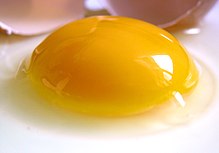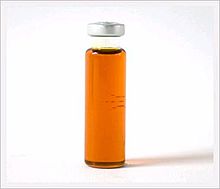
Egg oil (CAS No. 8001–17–0, INCI: egg oil), also known as egg yolk oil or ovum oil, is derived from the yolk of chicken eggs consisting mainly of triglycerides with traces of lecithin, cholesterol, biotin, xanthophylls lutein and zeaxanthin, and immunoglobulins. It is free of egg proteins and hence may be used safely by people who are allergic to eggs, for topical applications such as hair and skin care. The product has several historical references in Unani (Greek) medicine for hair care. Traditional Chinese medicine uses egg oil for burns, eczema, dermatitis, mouth ulcers, skin ulcers, chapped nipples, tinea capitis, ringworm, nasal vestibulitis, frostbite, and hemorrhoids.
Production

In alchemy, the oil was traditionally extracted from the yolk by a fairly simple process, by which fifty eggs yielded approximately five ounces of oil. Modern methods of production include liquid–liquid extraction using common solvents such as hexane, petroleum ether, chloroform, and ethanol. Unlike traditional egg oil produced by heat, solvent extracted product also contains immunoglobulins, which are destroyed at higher temperatures. There are only a few commercial producers globally.
Composition
The fatty acid composition of egg oil is rich in long-chain polyunsaturated fatty acids (LCPUFA) such as omega-3 fatty acids (including docosahexaenoic acid) and omega-6 fatty acids (including arachidonic acid), and closely resembles the fatty acid profile of human milk, as well as the lipid profile of human skin.
Complete fatty acid profile
Oleic acid (18:1) 37.6% Palmitic acid (16:0) 35.7% Linoleic acid (18:2) 10.7% Palmitoleic acid (16:1) 7.7% Stearic acid (18:0) 3.3% Myristic acid (14:0) 1.1% Docosahexaenoic acid (22:6) 0.5% Myristoleic acid (14:1) 0.4% Heptadecanoic acid (17:0) 0.3% Arachidonic acid (20:4) 0.2% Arachidic acid (20:0) 0.2% Linolenic acid (18:3) 0.1% Pentadecanoic acid (15:0) 0.1%
Typical analysis
Appearance Yellow coloured, hazy liquid Consistency Viscous liquid/thickened/Semi-solid at 25 C. Odour Mild characteristic odour of egg Refractive Index 1.46 – 1.48 Cholesterol 3% – 4.0% Specific Gravity 0.93 – 0.98@25 deg. C Gardner color scale 11 Max. Acid value < 35.0 (mg KOH/g) Iodine Value > 60
Uses
Cosmetics
Egg yolk has been used in traditional cosmetics since the eleventh century in Jewish, Greek, Arab, and Latin cultures. Several popular modern cosmetic brands contain egg oil.
Hair care
Egg oil is widely used in India for hair care.
Skin care
Egg oil can be used as an excipient/carrier in a variety of cosmetic preparations such as creams, ointments, sun-screen products, or lotions where it acts as an emollient, moisturizer, anti-oxidant, penetration enhancer, occlusive skin conditioner, and anti-bacterial agent.
Pharmaceuticals
Scabies
For treatment of scabies in Spain, oil of egg yolk was used along with oil of castor and roses in ancient Andalusia.
Wounds
Egg oil was traditionally used in treating wounds and injuries. In the 16th century, Ambroise Paré used a solution of egg yolk, oil of roses, and turpentine for war wounds, an old method that the Romans had discovered 1000 years before him. He published his first book The method of curing wounds caused by arquebus and firearms in 1545.
Infant nutrition
Egg oil is a potential source of polyunsaturated fatty acids such as docosahexaenoic acid and arachidonic acid for infant nutrition or combined with fish oil for infant formula production. It is also a source of vitamin D.
References
- The Journal of Nutrition 82:64 Jane B. Walker, Gladys Emerson
- "Xie Xinmei, Pang Xiaobin:Henan University (Medical Sciences)2012". Archived from the original on 2015-02-09. Retrieved 2013-01-18.
- US 4219585
- Samuel Frederick Gray (1821). A supplement to the pharmacopoeia: being a treatise on pharmacology in general. Thomas and George Underwood. p. 227. Retrieved Sep 6, 2016.
egg oil medicinal.
- Warren, M. W.; Brown, H. G.; Davis, D. R. (2014). "Solvent extraction of lipid components from egg yolk solids". Journal of the American Oil Chemists' Society. 65 (7): 1136. doi:10.1007/BF02660569. S2CID 83807139.
- Aleksandrs Kovalcuks, Mara Duma. "Solvent Extraction of Egg Oil of From Liquid Egg Yolk" (PDF).
- Tini M, Jewell UR, Camenisch G, Chilov D, Gassmann M (2002). "Generation and application of chicken egg-yolk antibodies". Comp. Biochem. Physiol. A. 131 (3): 569–574. doi:10.1016/S1095-6433(01)00508-6. PMID 11867282.
- American Journal of Clinical Nutrition
- P. Cavallo, M. C. Proto1, C. Patruno (April 2008). "The first cosmetic treatise of history - A female point of view". International Journal of Cosmetic Science. 30 (2): 79–86. doi:10.1111/j.1468-2494.2007.00414.x. PMID 18377616. S2CID 3758696.
{{cite journal}}: CS1 maint: multiple names: authors list (link) CS1 maint: numeric names: authors list (link) - Halldor Thormar (2010-12-28). Lipids and Essential Oils as Antimicrobial Agents. John Wiley & Sons. ISBN 9780470976678.
- "El Tratamiento De Las Enfermedades Infecciosas en Al-Andalus" (PDF). Rev Esp Quimioterap. 17 (4): 350–356. December 2004.
- US patent 2555731, W.B. Cooper, "Oil Produced from Eggs"
- Simopoulos, AP; Salem Jr, N (1992). "Egg yolk as a source of long-chain polyunsaturated fatty acids in infant feeding". The American Journal of Clinical Nutrition. 55 (2): 411–4. doi:10.1093/ajcn/55.2.411. PMID 1734678.
- US patent 4670285
- M. P. Sinha (2010-09-01). Csir-Ugc Net/jrf/slet General Sciences [paper-I (part-A). Upkar Prakashan. ISBN 9788174829023.
| Eggs | |
|---|---|
| List of egg topics | |
| Types | |
| Fossil record | |
| Biology | |
| Components | |
| As food | |
| In culture | |